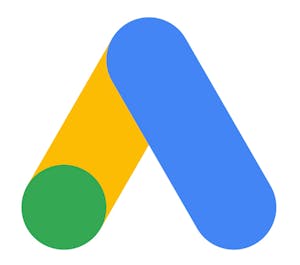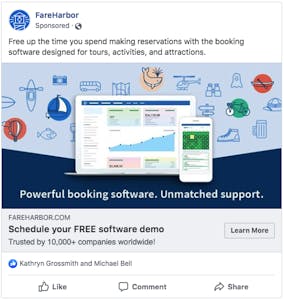- 4 minute read
- Digital Marketing
- SEO
- Websites
The Types of Photos You Must Include on Your Tour or Activity Site
Intermediate
Join hundreds of other operators and REGISTER NOW for Spark 2024 New Orleans October 13-15th!

Pay-per-click (PPC) advertising is a quick way to generate traffic to your website, in addition to other tactics like search engine optimization. Through PPC, it’s easy to target an audience with advertisements across several platforms, and you are only charged a fee when someone clicks on it.
Whether you’re positioning advertisements towards active searchers or re-marketing to customers who left your site without booking, PPC allows businesses to target potential customers throughout every step of the consumer journey.
Ready to dip your toe into PPC? This guide offers a breakdown of which types of PPC might be right for your business.
Before we get started, brush up on PPC terms, definitions, and how to launch your campaign, so you can decide which PPC options are best for your business.
PPC is much more than simply making your website appear at the top of the Search Engine Results Page (SERP). PPC can range from paid ads on social media networks to display networks and more. Use this guide to compare the different types of PPC and find the one (or more) that’s right for your tour and activity company.
 When considering how PPC can boost marketing efforts, it’s common to look to the world’s most popular search engine, Google. The two most common types of ads to run in Google are search ads and display ads. As these both play large roles in many advertising campaigns, it’s important to understand how and when to use them in your own search engine marketing efforts.
When considering how PPC can boost marketing efforts, it’s common to look to the world’s most popular search engine, Google. The two most common types of ads to run in Google are search ads and display ads. As these both play large roles in many advertising campaigns, it’s important to understand how and when to use them in your own search engine marketing efforts.
Search engine advertising targets active searchers using keywords in their search. For example, let’s say you teach cooking classes in Florence and want to advertise some of your upcoming workshops. If someone searches “cooking workshops in Florence,” and you bid on that keyword, your ad may appear in the sponsored section of the SERP, hopefully leading to a click — and a booking!
Advertising this way is a quick and cost-effective method to give you visibility on the SERP, even if the searcher doesn’t click your ad. The searcher will still see your business prominently listed, increasing the likelihood that they book with you in the future. Along with increased visibility, utilizing a search ad campaign has many additional benefits.
They also allow you to make quick, data-driven decisions that will help drive revenue and make the most of your marketing budget. Track which keywords are performing well and which ones aren’t making the cut, then adjust bids accordingly. Search ads allow you to target a specific audience based on location, intent, and interests. Bid on specific keywords that relate to a certain audience or demographic. For example, if the bookings for your pizza making class are low, target potential customers who are searching for keywords related to making pizza.
Finally, get the edge to rank over your competition. Quickly boost online visibility without focusing on organic search.
Search ads are a great fit for your business if:
Display ads appear on Google sites as well as thousands of Google partner websites. The added benefit of these partnerships is more exposure and awareness for your business. Display ads get your brand in front of customers whether they’re searching for your business or not.

The key difference between display ads and search ads is that display ads do not market based on intent (e.g. keywords) but rather focus on brand awareness. In fact, they have nothing to do with searching on a search engine at all. These ads can be in the form of banners, text, Gmail, and apps, so you’re always reaching a wide audience — even those people who weren’t necessarily looking for tours and activities in the first place!
This kind of advertising lets your brand stay visible when people are taking their time and browsing online without intent to make a booking — this is how people spend most of their time online, after all. Think of display ads as a soft push to sell your tours and activities, keeping your business top of mind no matter what people are looking for. However, this wide reach doesn’t mean your ads are running without a target audience. Advertisers can still reach a target audience by displaying their ads on selected websites or groupings of sites based on certain audience characteristics.
Display ads are the right move for your business if:
Despite the good effort to get visitors to complete a booking on your website, not every searcher who finds your business will make a booking the first time they visit. Retargeting, or remarketing, allows you to follow potential buyers with ads after they leave your site.

As a potential customer goes about their business online, they will be served up display ads based on cookie technology. A retargeting program gets your brand in front of an audience who has already visited your website and may just need an extra push to complete a booking. Past visitors who are already familiar with your brand are more likely to return to your site with some encouragement.
Consider this scenario: A tour operator runs walking tours in New York City. They notice people are browsing their website for Brooklyn activities but don’t complete a booking. The operator decides to create an ad group marketed towards an audience of people who browse “Brooklyn activities” on their site but leave without making a booking. They already know these searchers are likely planning a trip to the city or looking for something fun to do in Brooklyn, and now you have a chance to draw them back. The ad includes a special incentive to get them to book, like 10% off a t-shirt with the purchase of a tour.
If you already advertise on Google, retargeting is as simple as adding a piece of Google remarketing code to your website so visitors get added to a retargeting audience through browser cookies. You can create more specific audiences by customizing the code for different pages to correspond to certain categories.
Reaching out to past visitors certainly has its benefits! Retargeting is right for your business if:

Pro tip: Nobody wants to see the same retargeted ad over and over. Be sure to update your ads frequently to increase the chance of getting potential customers back to your website.
Whether you’ve already built an impressive social media presence or are just getting started with platforms like Facebook, Twitter, and Instagram, social networks are the ideal place to target potential customers with PPC advertising.
With so many networks out there, you can choose where to advertise based on your target audience. A network where content naturally fits in is an awesome place to start. For example, Pinterest has more female than male users, so if you sell an experience like custom bachelorette parties, your ads would be well placed there. Facebook is the most popular social media network out there, with a wide variety of users from different backgrounds and demographics, giving you more bang for your buck.
Facebook ads help build awareness, brand consideration, and conversions. Because Facebook is so popular across demographics and offers very detailed targeting options, it’s a great network to start with if you’re just getting the ball rolling with PPC advertising. Plus, with the opportunity to combine beautiful photos or videos with text, you can get creative with the ad content.

You can select your target audience in a variety of ways:
With such a level of specificity, Facebook lets you make the most of your budget and bids, encouraging conversions and engagement with your brand.
Twitter ads work toward several business objectives like earning website clicks and followers, increasing brand awareness and tweet engagements, and promoting tweets with app installs. There are two ways to create Twitter ads: Twitter Promote and Twitter ad campaigns.
 Twitter Promote: This option will automatically promote Tweets to a target audience, specifically your first 10 daily organic Tweets that pass the Twitter quality filter. It also promotes your account with the goal of attracting new followers. Focus on up to five metro locations or interests and sit back as Twitter handles the rest. There is a monthly fee and Twitter states that accounts on average should reach an additional 30,000 people per month just by using the service.
Twitter Promote: This option will automatically promote Tweets to a target audience, specifically your first 10 daily organic Tweets that pass the Twitter quality filter. It also promotes your account with the goal of attracting new followers. Focus on up to five metro locations or interests and sit back as Twitter handles the rest. There is a monthly fee and Twitter states that accounts on average should reach an additional 30,000 people per month just by using the service.
Twitter ad campaigns: Start by choosing a business objective that aligns with your goals, like including a website card to get clicks to your website. Create Tweets specifically as ads or promote existing organic Tweets. Set a budget and choose your bids based on how much you want to pay for each interaction (video view, app install, etc.), and you’re on your way to more engagement and new followers!
While Facebook and Twitter are just two examples of how you can advertise on social media, other platforms like Instagram, Snapchat, and others have amazing benefits. Social media campaigns are right for your business if:
Remember, you don’t have to limit your business to just one type of PPC advertising! In fact, the biggest benefit of PPC advertising is that all of the different options work hand in hand and enhance your overall digital marketing strategy. To test the waters, pick the type that you think will work best for your business and see how to can expand from there. For some reminders about optimizing your landing page, launching your campaign, and general PPC tips, see our PPC breakdown guide.